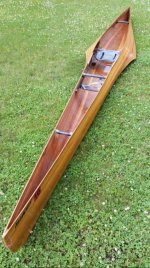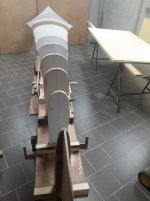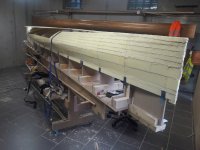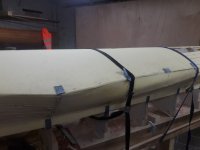I'm Francis from Belgium and a ultra-marathon canoe racer (5 x Yukon River Quest). Next year, I want to participate in a race in the UK with 78 portages, so I want to build a C1 canoe (see picture) as light as possible. I built already 2 strippers, but the question is now, again in WRC or in composite.
Let me first explain how I built my 2 previous strippers:
C1 - stock racing canoe simular model as the Blackwater of Savage River
17' long
cedarstrips aournd 5 mm thick
Outside: 1 layer 6oz E-glass - 3 coats epoxy - 2 layers Varnish Epifanes
Inside: 1 layer 2,8oz E-glass - 2 layers epoxy - 2 layers Varnish Epifanes
Seat + pedestral: carbon
Thwarts: alu-tube
Gunwale: only innerside - Ayous/abachi
Total Weight: 15 kg
My C2 - 18'6" long
Cedarstrips: 4,7 mm = 3/16"
Outside: 1 layer 4 oz S-glass - 2 coats epoxy - not yet varnished
Inside: 1 layer 4 oz S-glass - 1 coat epoxy - not yet varnished
Seats: Carbon
Bulkheads: Corecell laminated with carbon
Seatrails: Alu
Thwarts: Abachi/Ayous
Gunwale: only innerside - Ayous/abachi
Total weight: 19 kg
So the goal for my next build is a light and stiff C1 racer
I have different ideas and building techniques but have a lot of questions to help me in the decission:
Option 1:
Strip build in WRC thickness 1/8"
Outside: wet hand-lay-up of Carbon fibre, but with the odd shape of the boat I think I need Twill Weave Carbon, but I can find that only in 6 oz
How many coats of epoxy do I need?
Can I use vacuum-bagging and/or infusion
Some say, that vacuum-bagging don't help because it's only 1 thin layer of fabric..
Inside: 4 oz S-glass
Thwarts: Foam covered with a carbon sleeve. Corecell or an other foam?
Gunwale: Same technique as thwart
Seat: Carbon
Option 2:
Replace the cedar strips with foam strips PVC, divinycell or Corecell
What is the advantage vs cedar strips? I think the foam absorbs more epoxy resin
Laying the strips on an female or male mold?
When working in a female mold, just make 2 halfs of the hull and then join it together?
200 or 300 gr. Carbon fiber - Twill Weave for in- and outside
Is 1 coat of epoxy enough?
Is it necessary to lay a light layer of fiberglass on the outside to protect the carbon skin?
Option 3
Making a mold and do a full composite layup
Disadvantage: because it's only to make 1 boas, maybe this option takes to much work and is to expensive?
I know a guy who has experience with vacuum bagging and infusion,.so he can help me with that process.
Thanks
Francis
Let me first explain how I built my 2 previous strippers:
C1 - stock racing canoe simular model as the Blackwater of Savage River
17' long
cedarstrips aournd 5 mm thick
Outside: 1 layer 6oz E-glass - 3 coats epoxy - 2 layers Varnish Epifanes
Inside: 1 layer 2,8oz E-glass - 2 layers epoxy - 2 layers Varnish Epifanes
Seat + pedestral: carbon
Thwarts: alu-tube
Gunwale: only innerside - Ayous/abachi
Total Weight: 15 kg
My C2 - 18'6" long
Cedarstrips: 4,7 mm = 3/16"
Outside: 1 layer 4 oz S-glass - 2 coats epoxy - not yet varnished
Inside: 1 layer 4 oz S-glass - 1 coat epoxy - not yet varnished
Seats: Carbon
Bulkheads: Corecell laminated with carbon
Seatrails: Alu
Thwarts: Abachi/Ayous
Gunwale: only innerside - Ayous/abachi
Total weight: 19 kg
So the goal for my next build is a light and stiff C1 racer
I have different ideas and building techniques but have a lot of questions to help me in the decission:
Option 1:
Strip build in WRC thickness 1/8"
Outside: wet hand-lay-up of Carbon fibre, but with the odd shape of the boat I think I need Twill Weave Carbon, but I can find that only in 6 oz
How many coats of epoxy do I need?
Can I use vacuum-bagging and/or infusion
Some say, that vacuum-bagging don't help because it's only 1 thin layer of fabric..
Inside: 4 oz S-glass
Thwarts: Foam covered with a carbon sleeve. Corecell or an other foam?
Gunwale: Same technique as thwart
Seat: Carbon
Option 2:
Replace the cedar strips with foam strips PVC, divinycell or Corecell
What is the advantage vs cedar strips? I think the foam absorbs more epoxy resin
Laying the strips on an female or male mold?
When working in a female mold, just make 2 halfs of the hull and then join it together?
200 or 300 gr. Carbon fiber - Twill Weave for in- and outside
Is 1 coat of epoxy enough?
Is it necessary to lay a light layer of fiberglass on the outside to protect the carbon skin?
Option 3
Making a mold and do a full composite layup
Disadvantage: because it's only to make 1 boas, maybe this option takes to much work and is to expensive?
I know a guy who has experience with vacuum bagging and infusion,.so he can help me with that process.
Thanks
Francis




